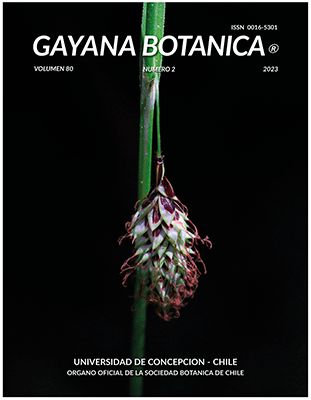Vascular flora of the Putaendo mountain range (32° S, 70° W): scarcely studied and threatened Andes of the Valparaíso Region, Central Chile
DOI:
https://doi.org/10.4067/S0717-66432023000200158Keywords:
Andean flora, Chilean hotspot, mediterranean ecosystems, plant diversity, taxonomyAbstract
The Putaendo mountain range is located in the Andes of Valparaíso and there are few studies on its flora and vegetation, which is a limitation for the evaluation of the conservation status of this environment that has a diversity of uses, in some cases in conflict. A species inventory was carried out through 15 field campaigns, between 2016-2022, between the months of October and March, in the three main watersheds: Rocín river, Hidalgo river and Chalaco estuary. As a result, a record of 501 taxa distributed in 77 families and 240 genera was obtained. The flora reported represents 26.5 % of the flora of the Valparaíso Region. The richest families are Asteraceae, Fabaceae, Poaceae and Calceolariaceae. Nine genera are endemic to Chile. According to their phytogeographic status, 318 (64 %) are native, 161 (32 %) are endemic to Chile and 22 (4 %) are allochthonous. Seventy-one percent of the taxa are herbaceous and 29 % are woody. The highest richness and degree of endemism was recorded between 1100-2500 m.a.s.l. Eight threatened species are reported, 45 new taxa are reported for the Valparaíso region and 34 new species distribution limits. Finally, the list of microendemic species and those that are scarce in the study area or poorly represented in reference herbaria is reported.
Downloads
Metrics
Downloads
Additional Files
Published
How to Cite
Issue
Section
License
Copyright (c) 2024 Aron Cádiz-Véliz, Patricio Novoa Quezada, Andrés Moreira-Muñoz

This work is licensed under a Creative Commons Attribution-NonCommercial 4.0 International License.
Authors who publish with this journal agree to the following terms:
- Authors retain copyright and grant the journal right of first publication.
- The articles in this journal are published under Creative Commons Attribution-NonCommercial 4.0 International License that allows others to share the work with an acknowledgement of the work's authorship and initial publication in this journal.
- Authors are permitted and encouraged to post their work online (e.g., in institutional repositories, on their website or ResearchGate) prior to and during the submission process, as it can lead to productive exchanges, as well as earlier and greater citation of published work (SeeThe Effect of Open Access).













